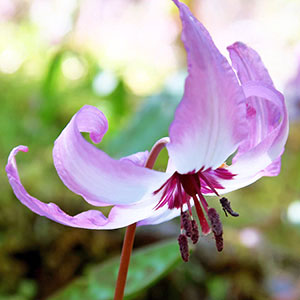Erythronium hendersonii
Erythronium oregonum
Henderson's fawn-lily
deer's tongue, giant fawn-lily, giant white fawn-lily, Oregon fawn-lily, white fawn lily, wild Easter lily
slender, 40–55 mm.
narrowly ovoid, 25–60 mm, sometimes producing sessile offsets.
10–25 cm;
blade mottled with irregular streaks of brown or white, oblong to ovate, margins entire to ± wavy.
12–25 cm;
blade distinctly mottled with irregular streaks of brown or white, ovate to broadly lanceolate, margins wavy.
reddish, 12–30 cm.
± reddish, 15–40 cm.
1–4-flowered.
1–3-flowered.
tepals violet to pink, darker at tips, dark purple at base, broadly lanceolate, 18–35 mm, inner with small auricles at base;
stamens 10–14 mm;
filaments violet-purple, linear, slender, less than 0.8 mm wide;
anthers pale brown to purple;
style violet, 6–8 mm;
stigma unlobed or with lobes shorter than 1 mm.
tepals white to creamy white with yellow base at anthesis, sometimes pinkish in age, sometimes with red lines or bands, elliptic to narrowly ovate, 25–40 mm, inner with small auricles at base;
stamens 12–25 mm;
filaments white, flattened, ± lanceolate, 2–3 mm wide;
anthers cream to yellow;
style white, 12–18 mm;
stigma with recurved lobes 3–6 mm.
obovoid, 2–4 cm.
oblong to narrowly obovoid, 3–5 cm.
= 24.
= 24.
Erythronium hendersonii
Erythronium oregonum
Forms from the southern part of the range with cream-white tepals and pale anthers have been described as subsp. leucandrum. This species is closely related to E. revolutum and occasionally hybridizes with it where their ranges meet. In addition, E. citrinum and E. hendersonii are reported to hybridize with E. oregonum in the southern part of its range.
(Discussion copyrighted by Flora of North America; reprinted with permission.)
- Local floras:
BC,
CA,
OR,
WA
- Local Web sites:
CalFlora,
CalPhotos,
Flora NW,
PNW Herbaria,
Turner Photog.
WildflowerSearch
iNaturalist (observations)
USDA Plants Database
- LBJ Wildflower Center
- SEINet
- Plants of the World Online
- Encyclopedia of Life
- Wikipedia
- Google Image Search
